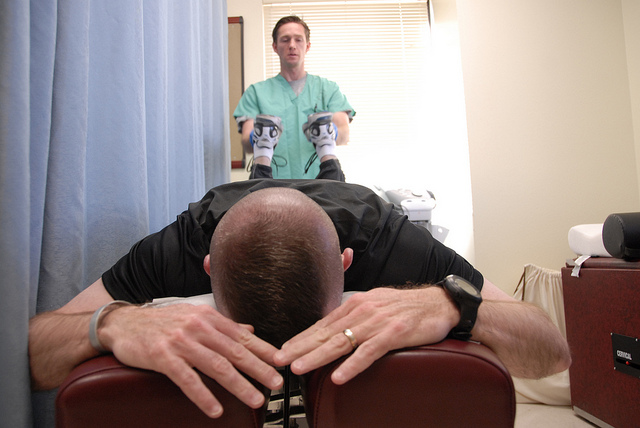When I was pregnant, I blatantly ignored the aches and pains during lunges.
I ended up being acutely injured, and it led me to chronic pain. My body was clearly sending me signals that something was not right, but I ignored them. It basically told me, “F*ck this sh*t, I’m not letting you do that. Here is debilitating pain that will make you stop.”
In my previous article, I discuss how pain is 100 percent created in the brain. You might want to check that out before reading this one.
The next thing that is important to know is that the brain is not always rational when deciding what should hurt and what shouldn’t—this is where some mindful analyzing can be helpful.
Now, let’s be clear. If we’ve just placed our hand on a hot stove, we don’t need to analyze anything. We need the brain to jump in and do its thing: to make us pull our hand away before we can even have a conscious thought. But that isn’t the pain I am talking about here. I’m talking about any chronic pain: one that has been lasting more than three or six months.
Many pain stories start small: a tolerable backache when sitting for too long or a little dribble of pee when laughing or sneezing. What do we do? We ignore it, complain about it a little bit, maybe get a massage, and then forget about it.
Sometimes, our body talks to us in other ways, such as anxiety, tension, thirst, hunger, or gut pain.
When we neglect these subtle signs, we forget them when intense pain comes along, especially if our pain severely ramps up or we “throw our back out” after bending down to pick up a pencil. That pain may feel like it came out of nowhere, when in fact, there have been subtle signs along the way that something was not quite right.
This can unintentionally teach our body that lots of pain equals “my human stops and pays attention.”
So all along, a body may have been screaming through tension, anxiety, or aches that say, “Hey, we really hate our job, and our boss is a gaslighting bully,” but that didn’t quite get our attention. Then, our body thinks, “Oh, I know what can make you listen.”
While this happens on a subconscious level, there are also real physiological changes that occur. Have you ever walked into an intimidating meeting and felt yourself tighten up? Yes, those are actual muscle contractions that lead to decreased oxygen and blood flow to the muscles.
When we walk around in a state of low (or high) level anxiety all day, this creates measurable changes in the body. Or when we forget to drink enough water, it makes our blood more viscous and our muscle sticky and stiff.
But here is where things get fun. There are many people out there with tight and dehydrated muscles that have no pain. It is only when the brain decides this is a threat, that it starts to make someone pay attention to it via pain. And everyone’s brain is going to have a different threat level based on genetic makeup, past experiences, exposure to chemicals, and the types of beliefs one was raised with, along with things one has been told (regardless of whether or not they are believed).
This is where two people with incredibly similar pasts and stories can have different healing journeys. I remember treating two women with similar pain patterns. Growing up, they both had mothers who experienced chronic pain. One, however, had a mom who worked through it, put on a happy face, and taught her kids to “toughen up and get over it.” The other had a mom to whom she became the caretaker at a young age, as her mom was unable to take care of herself due to her pain.
Guess whose pain was more debilitating? I bet you guessed wrong. It was the first one—the one who was told to toughen up. But this is also irrelevant, because there is absolutely no way to predict the answer. It could have just as easily been flip-flopped. Because it is all about what your brain decides to do with information given to it as a child. And then, it combines it with beliefs we consciously or unconsciously pick up throughout our lives.
My first client’s empathic brain saw how debilitating pain was for her mom and hated how she hid and ignored her pain, and therefore decided it would not allow her to do this. My second client refused to “become like her mom” and tried to force herself to “toughen up,” but her brain decided this approach was unsafe because she was not listening to the cues it gave her.
Now let me be clear. Neither of their mindsets was particularly helpful or healthy. Both were fundamentally pushing away what their body was trying to tell them. This is what the brain interprets as a threat, and what will lead to an upregulation of pain in the central nervous system. Understanding this is essential to our healing journey, because despite similar pain, their journeys and the work we did together was way different.
Our bodies inherently know what we need. But this “gut feeling” or “intuition” is often stripped from us. Think of every time you fell, got hurt, and were told “its okay,” when it really hurt. Or every time you were angry or sad and were told to “calm down” or “it isn’t a big deal.” All of these seemingly little and even harmless things happened over and over throughout our childhood and our lives. Especially if you are a woman, then the ways they happen might be different. One child is forced to clean their plate, another may be chastised for wanting to eat more. Either way, it teaches the child that their internal hunger and fullness messages cannot be trusted.
This is when a healing journey that is individualized to a person and their particular brain is so crucial. This is why some advice can work wonders for one person, but make someone else worse. This is also why non-individualized protocols can be so harmful. Sure, if by chance the protocol matches the person, it may be amazing. But if not, it can leave a person feeling dejected and hopeless.
The good news is, there is no one perfect way for anyone. All journeys will be messy with roundabouts, dead-ends, and times when someone is completely lost. This is normal.
But one of the best ways to start is by listening to our bodies. Maybe just getting up right when we feel thirsty or need to use the bathroom. Or just noticing “Wow, I feel tension whenever I pass my coworker in the hall.” Or it could be as simple as placing our hand on our heart and letting our body know, “I have no idea to what I am listening, but I am. I may not answer, but I am trying to hear you. I want to hear what you have to say.”
~












Read 0 comments and reply